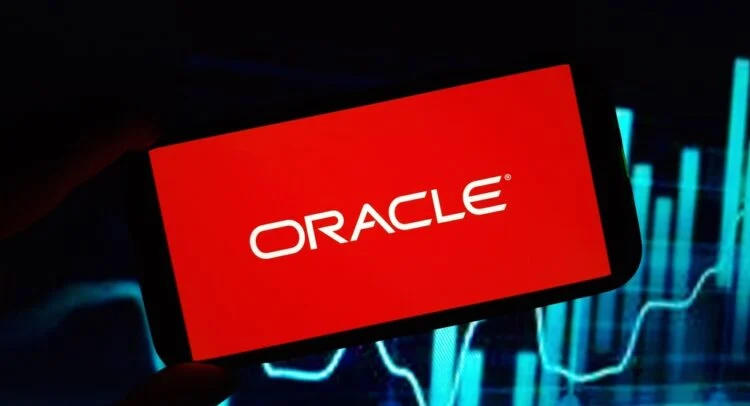Sometimes the market delivers a reminder that even the most seasoned investors can get caught off guard. Oracle’s stock just did exactly that, rocketing 28.36% in extended trading after delivering Q1 results that left analysts literally speechless. When CNBC runs headlines about analysts being “slack-jawed” and admitting “We’re all kind of in shock,” you know something significant just happened.
Let’s cut through the noise and figure out what Oracle just pulled off – and whether this is the start of something bigger or just another earnings sugar rush that’ll fade by Thursday.
The Numbers That Made Wall Street Blink
First, the headline figures. Oracle delivered $14.9 billion in total revenue, up 12% year-over-year, with non-GAAP earnings per share of $1.47, up 6%. Those numbers are solid but hardly earth-shattering. What really got investors’ attention was the forward-looking stuff – specifically, Oracle’s cloud infrastructure guidance and that absolutely bonkers backlog number.
Here’s where it gets interesting: remaining performance obligations hit $455 billion, up 359%. Let that sink in. We’re talking about nearly half a trillion dollars in contracted future revenue. That’s not a typo, and that’s not normal.
The cloud infrastructure piece is where Oracle is really making moves. While the exact Q1 IaaS numbers aren’t broken out in the initial reports, the trajectory is clear when you look at the recent quarters. This is Oracle’s bet-the-farm moment on becoming the fourth major cloud hyperscaler alongside AWS, Microsoft Azure, and Google Cloud.
Why This Isn’t Your Average Earnings Beat
Oracle has been playing a different game than most people realized. While everyone was focused on the big three cloud providers duking it out, Larry Ellison and team quietly positioned Oracle as the AI infrastructure play that actually makes sense.
Here’s the thing about Oracle’s cloud strategy that Wall Street is finally waking up to: they’re not trying to be everything to everyone. They’re laser-focused on the enterprise workloads that require serious performance, security, and integration with existing Oracle databases. It’s not sexy, but it’s incredibly lucrative.
The shares, trading at $310 in extended trading, are set to zoom past their record close of $256.43, which puts Oracle’s market cap north of $870 billion. For context, that puts them in the conversation with companies like Tesla and Meta. Not bad for a database company that many people still think of as legacy enterprise software.
The AI Infrastructure Gold Rush
What’s really driving this move isn’t just good quarterly numbers – it’s the realization that Oracle has positioned itself perfectly for the AI infrastructure buildout that’s happening right now. Every company scrambling to implement AI solutions needs somewhere to run those workloads, and Oracle’s cloud infrastructure is increasingly becoming the answer for enterprises that can’t afford downtime or security breaches.
Think about it: when a bank or healthcare company wants to implement AI, they’re not going to experiment with the cheapest cloud provider. They’re going with the company that has 40+ years of experience handling mission-critical enterprise data. That’s Oracle’s moat, and it’s deeper than most people appreciated.
The multicloud partnerships Oracle has been building also matter more now. Instead of forcing customers to choose one cloud provider, Oracle is positioning itself as the enterprise-grade option that plays nicely with whatever else you’re running. It’s a smart strategy that acknowledges how real enterprises actually operate.
The Skeptic’s Case (Because Someone Has to Say It)
Before we all get carried away, let’s acknowledge the elephant in the room: Oracle has had false dawns before. The company has been promising a cloud transformation for years, and while they’ve made real progress, they’re still playing catch-up to AWS and Microsoft in terms of overall market share.
The massive backlog number, while impressive, also raises questions about execution. Having $455 billion in contracted revenue is great, but delivering on it profitably is what actually matters. Oracle has historically been very good at selling long-term contracts, but the cloud infrastructure business requires a different kind of operational excellence.
There’s also the valuation question. Even before this after-hours pop, Oracle was trading at premium multiples. A 28% one-day gain pushes the stock into territory where everything needs to go perfectly for the next few years to justify the price.
What This Means for Your Portfolio
If you’re wondering whether to chase Oracle at these levels, the answer depends on your investment timeline and risk tolerance. The company has clearly hit an inflection point in its cloud transformation, but buying after a 28% after-hours move isn’t exactly buying low.
For long-term investors, Oracle represents something interesting: a mature technology company that’s successfully reinventing itself for the AI era. The database moat is real, the enterprise relationships are deep, and the management team has proven they can execute on multi-year strategic shifts.
For shorter-term traders, this move creates some interesting dynamics. Oracle shares are up 45% in 2025 as of Tuesday’s close, and if the after-hours gains are sustained, the stock is expected to record its best day since the dot-com bubble peak of mid-1999. That’s the kind of momentum that can feed on itself, especially if Oracle delivers on the guidance they just laid out.
The Broader Tech Rotation Story
Oracle’s move also reflects something bigger happening in tech right now. Investors are rotating toward companies that actually make money from AI rather than just talking about it. Oracle’s cloud infrastructure business is generating real revenue from companies that need to run AI workloads today, not someday.
This is different from the speculative AI plays that dominated headlines for the past year. Oracle is benefiting from the practical implementation phase of AI adoption, where enterprises are moving beyond pilot projects and actually deploying solutions at scale.
Looking Forward: Can Oracle Keep This Up?
The key question is whether Oracle can sustain this momentum. The company has laid out an ambitious roadmap for cloud infrastructure expansion, and the early results are encouraging. But going from scrappy challenger to legitimate hyperscaler competitor requires flawless execution on a massive scale.
Oracle’s advantage is that they don’t need to win the entire cloud market – they just need to dominate the enterprise segment where security, performance, and integration matter more than price. It’s a smaller addressable market, but it’s also more profitable and defensible.
The management team deserves credit for making some tough strategic decisions over the past few years. Shifting resources from traditional license sales to cloud infrastructure wasn’t easy, and there were quarters where the transition looked painful. This earnings report suggests those investments are finally paying off.
The Bottom Line
Oracle’s 28% after-hours surge isn’t just about one good quarter – it’s the market finally recognizing a transformation that’s been years in the making. Whether you buy the stock or not, you can’t ignore what Oracle has accomplished in positioning itself as the enterprise AI infrastructure play.
The company has built something valuable: a cloud platform that enterprises actually trust with their most critical workloads. In a world where AI is moving from experiment to production, that trust translates directly into revenue growth and margin expansion.
Will Oracle sustain these gains? That depends on execution. But for the first time in years, Oracle has given investors a reason to believe that Larry Ellison’s vision of dominating enterprise computing might actually become reality. That’s worth paying attention to, even if you decide the current price is too rich for your blood.
The market has spoken, and it’s saying Oracle isn’t just surviving the cloud transition – it’s starting to win it.



